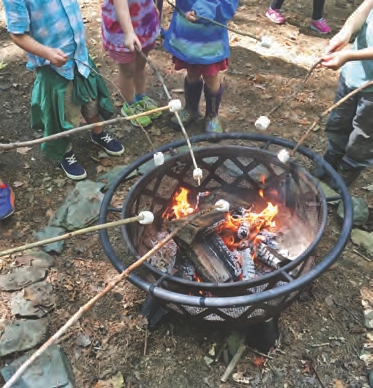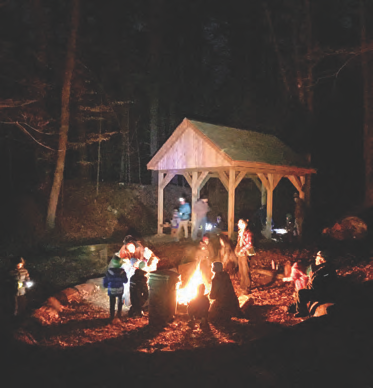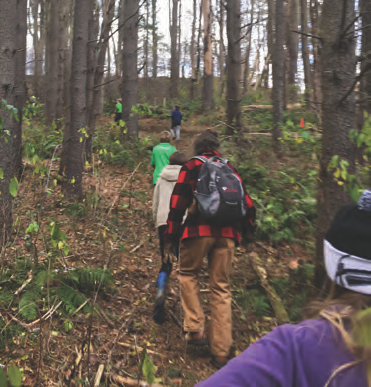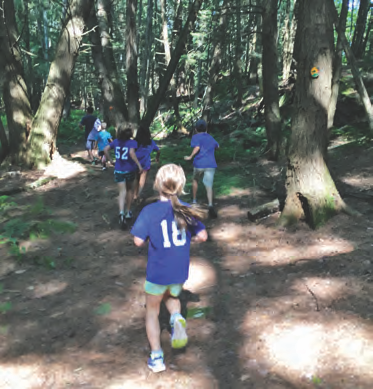Welcome to the Milton Frye Nature Area
Published Mar 1st, 2018 by Brie Swenson, David Hubbard, and Lindsay Putnam
 In December, the Marion Cross Kindergarten held a Lantern Walk and marshmallow roast.
In December, the Marion Cross Kindergarten held a Lantern Walk and marshmallow roast.
There is a lot going on in the Milton Frye Nature Area these days. Marion Cross School children are learning how to interact with and respect their outdoor environment, how to properly build and maintain a trail system, as well as continuing to assist in invasive plant management. Current and upcoming community-wide events include a series of workshops and walks that began in December and continue in February with a tracking event led by the Norwich Conservation Commission. This 35-acre hidden gem located in the heart of the Village is a tremendous natural resource for our town.
 In December, the Marion Cross Kindergarten held a screening of The Best Day Ever, a documentary about the value of outdoor education.
In December, the Marion Cross Kindergarten held a screening of The Best Day Ever, a documentary about the value of outdoor education.
The history of the Nature Area goes back to 1974, when the town acquired the majority of the land from the Peisch Family. A second adjoining parcel was later donated by the Lewis Family. The Nature Area was protected via town ballot in 2001, under a conservation easement that is held by the Upper Valley Land Trust. The effort to permanently protect the parcel was led by Norwich Special Places, a citizen group that worked to identify and facilitate the protection of key open spaces in Norwich. A committee of community volunteers, known as The Milton Frye Nature Area Committee, oversaw the management of the Nature Area for many years. It is now managed by a subcommittee of the Norwich Conservation Commission, which is working to update the Forest Management Plan, furthering community outreach with educational and recreational programming and continuing the work of preserving a thriving and diverse native ecosystem.
 Marion Cross LEEEP Coordinator, Lindsay Putnam, leads a trail stewardship elective on a new trail in town that is being primarily constructed by Marion Cross students that begins in the Nature Area.
Marion Cross LEEEP Coordinator, Lindsay Putnam, leads a trail stewardship elective on a new trail in town that is being primarily constructed by Marion Cross students that begins in the Nature Area.
Entering the village of Norwich, the open field and orchard on your right constitutes the southwestern boundary of the Nature Area. The main trail entrance is accessed from the parking lot behind the Marion Cross School, leading you to three interconnected loop trails and an outdoor education shelter. The Nature Area has a diverse terrain of geologic features that leads to a wide variety of flora and fauna. Current and future efforts to manage invasive plants focus on species such as Norway maple, buckthorn, burning bush, honeysuckle, bittersweet and Amynthas agrestis, or ‘crazy snake worms.’
 Trail running in the Nature Area is a very popular activity for all ages.
Trail running in the Nature Area is a very popular activity for all ages.
Despite the in-town location and relatively small acreage, a wide variety of wildlife is either in residence or occasionally passes through. Fisher make their natal dens in the hollows of the ancient giant sugar maples which are scattered throughout the area. Raccoons also take advantage of the old trees and foxes dig their dens in the south facing banks near the edge of the meadow. Rare sightings of bear, moose and bobcat have occurred. Deer are full-time residents, often sheltering in the overgrown southwest corner. Their continual browsing of the understory is a problem, inhibiting young hardwood regeneration and limiting food sources for other species.
Overall, the incredible value of the Milton Frye Nature Area can be seen in its role as an outdoor education classroom, a readily accessible recreation area, and conserved open space of forest and field.
Originally published in Winter/Spring 2018 Norwich Times